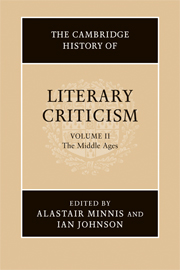Book contents
- Frontmatter
- Introduction
- I THE LIBERAL ARTS AND THE ARTS OF LATIN TEXTUALITY
- II THE STUDY OF CLASSICAL AUTHORS
- III TEXTUAL PSYCHOLOGIES: IMAGINATION, MEMORY, PLEASURE
- IV VERNACULAR CRITICAL TRADITIONS: THE EARLY MIDDLE AGES
- V VERNACULAR CRITICAL TRADITIONS: THE LATE MIDDLE AGES
- 14 Latin commentary tradition and vernacular literature
- 15 Vernacular literary consciousness c. 1100–c. 1500: French, German and English evidence
- 16 Occitan grammars and the art of troubadour poetry
- 17 Literary theory and polemic in Castile, c. 1200–c. 1500
- 18 Literary criticism in Middle High German literature
- 19 Later literary criticism in Wales
- VI LATIN AND VERNACULAR IN ITALIAN LITERARY THEORY
- VII BYZANTINE LITERARY THEORY AND CRITICISM
- Bibliography
- Index
- References
17 - Literary theory and polemic in Castile, c. 1200–c. 1500
from V - VERNACULAR CRITICAL TRADITIONS: THE LATE MIDDLE AGES
Published online by Cambridge University Press: 28 March 2008
- Frontmatter
- Introduction
- I THE LIBERAL ARTS AND THE ARTS OF LATIN TEXTUALITY
- II THE STUDY OF CLASSICAL AUTHORS
- III TEXTUAL PSYCHOLOGIES: IMAGINATION, MEMORY, PLEASURE
- IV VERNACULAR CRITICAL TRADITIONS: THE EARLY MIDDLE AGES
- V VERNACULAR CRITICAL TRADITIONS: THE LATE MIDDLE AGES
- 14 Latin commentary tradition and vernacular literature
- 15 Vernacular literary consciousness c. 1100–c. 1500: French, German and English evidence
- 16 Occitan grammars and the art of troubadour poetry
- 17 Literary theory and polemic in Castile, c. 1200–c. 1500
- 18 Literary criticism in Middle High German literature
- 19 Later literary criticism in Wales
- VI LATIN AND VERNACULAR IN ITALIAN LITERARY THEORY
- VII BYZANTINE LITERARY THEORY AND CRITICISM
- Bibliography
- Index
- References
Summary
The first signs of a critical stance towards poetic composition in the Castilian vernacular are to be found in the clerkly metre of cuaderna vía, which accompanied the emergence in the early thirteenth century of a new class of university–trained clerics. Writers such as Gonzalo de Berceo and the anonymous poets of the Libro de Alexandre and Libro de Apolonio introduced their narratives with self–conscious statements about their ‘clerical ministry’ (mester de clerecía) and their role as intermediaries between the laity and the received wisdom of bookish authority. Theirs, they claimed, was a new poetic movement, superior to the work of juglares (minstrels), and characterised by its metrical polish and civilising goals. These prefatory remarks are undeveloped (and have been variously interpreted), but they are nonetheless significant. They are evidence for the fact that, for the period in question, what may loosely be called ‘literary theorising’ was undertaken fundamentally in order to establish a social relationship: it is, so to speak, literary theory ‘in action’. This is to say that those who wrote for a lay public were less concerned with philosophising about an abstract category later to be called ‘literature’, than with defending their status as writers, and confronting the problems that attended the composition and interpretation of their own work. Thus, although theoretical treatises were written during this period, theory and criticism find expression principally through the medium of the literary text itself, prologues and, later, commentaries on specific works in the Castilian vernacular tradition.
- Type
- Chapter
- Information
- The Cambridge History of Literary Criticism , pp. 496 - 532Publisher: Cambridge University PressPrint publication year: 2005



